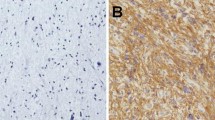Abstract
TRAP1/Hsp75 (tumor necrosis factor receptor-associated protein 1), a paralogue of the Hsp90 family, has been recently described as a molecular marker and novel therapeutic target in local and metastatic prostate cancer. It has been proved to be associated with tumor invasion and metastasis in various human malignancies. In our study, the protein expression level of TRAP1 in 236 cases of glioma is investigated by immunohistochemistry assay. Statistical analysis was utilized to evaluate the association of TRAP1 with clinicopathological characteristics and prognosis of patients. It was proved that TRAP1 protein expression was increased in glioma compared with that in normal brain tissue. Moreover, TRAP1 immunohistochemical staining was correlated with World Health Organization (WHO) grade and Karnofsky performance score (KPS). Strong positive TRAP1 staining is more frequently detected in glioma of advanced grade or low KPS. It is also demonstrated that TRAP1 could be an independent negative prognostic factor in glioma, for patients with glioma of strong TRAP1 staining tend to have high risk of death. These results proved that TRAP1 is associated with prognosis of glioma, which may also suggest the potential role of TRAP1 in glioma management.


Similar content being viewed by others
References
Altieri DC, Stein GS, Lian JB, Languino LR (2012) TRAP-1, the mitochondrial Hsp90. Biochim Biophys Acta 1823:767–773
Avgeropoulos NG, Batchelor TT (1999) New treatment strategies for malignant gliomas. Oncologist 4:209–224
Canadian Cancer Society’s Steering Committee: Canadian Cancer Statistics (2010) Toronto: Canadian Cancer Society; 2012. http://www.cancer.ca/statistics
Costantino E, Maddalena F, Calise S, Piscazzi A, Tirino V, Fersini A, Ambrosi A, Neri V, Esposito F, Landriscina M (2009) TRAP1, a novel mitochondrial chaperone responsible for multi-drug resistance and protection from apoptotis in human colorectal carcinoma cells. Cancer Lett 279:39–46
Ducray F, Idbaih A, Wang XW, Cheneau C, Labussiere M, Sanson M (2011) Predictive and prognostic factors for gliomas. Expert Rev Anticancer Ther 11:781–789
Felts SJ, Owen BA, Nguyen P, Trepel J, Donner DB, Toft DO (2000) The hsp90-related protein TRAP1 is a mitochondrial protein with distinct functional properties. J Biol Chem 275:3305–3312
Gupta K, Salunke P (2012) Molecular markers of glioma: an update on recent progress and perspectives. J Cancer Res Clin Oncol 138:1971–1981
Hua G, Zhang Q, Fan Z (2007) Heat shock protein 75 (TRAP1) antagonizes reactive oxygen species generation and protects cells from granzyme M-mediated apoptosis. J Biol Chem 282:20553–20560
Jemal A, Bray F, Center MM, Ferlay J, Ward E, Forman D (2011) Global cancer statistics. CA Cancer J Clin 61:69–90
Jin Y, Murata H, Sakaguchi M, Kataoka K, Watanabe M, Nasu Y, Kumon H, Huh NH (2012) Partial sensitization of human bladder cancer cells to a gene-therapeutic adenovirus carrying REIC/Dkk-3 by downregulation of BRPK/PINK1. Oncol Rep 27:695–699
Kang BH, Plescia J, Dohi T, Rosa J, Doxsey SJ, Altieri DC (2007) Regulation of tumor cell mitochondrial homeostasis by an organelle-specific HSP90 chaperone network. Cell 131:257–270
Kleihues P, Burger PC, Scheithauer BW (1993) The new WHO classification of brain tumours. Brain Pathol 3:255–268
Kleihues P, Louis DN, Scheithauer BW, Rorke LB, Reifenberger G, Burger PC, Cavenee WK (2002) The WHO classification of tumors of the nervous system. J Neuropathol Exp Neurol 61:215–225
Landriscina M, Amoroso MR, Piscazzi A, Esposito F (2010) Heat shock proteins, cell survival and drug resistance: the mitochondrial chaperone TRAP1, a potential novel target for ovarian cancer therapy. Gynecol Oncol 117:177–182
Leav I, Plescia J, Goel HL, Li J, Jiang Z, Cohen RJ, Languino LR, Altieri DC (2010) Cytoprotective mitochondrial chaperone TRAP-1 as a novel molecular target in localized and metastatic prostate cancer. Am J Pathol 176:393–401
Masuda Y, Shima G, Aiuchi T, Horie M, Hori K, Nakajo S, Kajimoto S, Shibayama-Imazu T, Nakaya K (2004) Involvement of tumor necrosis factor receptor-associated protein 1 (TRAP1) in apoptosis induced by beta-hydroxyisovalerylshikonin. J Biol Chem 279:42503–42515
Montesano Gesualdi N, Chirico G, Pirozzi G, Costantino E, Landriscina M, Esposito F (2007) Tumor necrosis factor-associated protein 1 (TRAP-1) protects cells from oxidative stress and apoptosis. Stress 10:342–350
Neckers L, Kern A, Tsutsumi S (2007) Hsp90 inhibitors disrupt mitochondrial homeostasis in cancer cells. Chem Biol 14:1204–1206
Nguyen MC, Tu GH, Koprivnikar KE, Gonzalez-Edick M, Jooss KU, Harding TC (2010) Antibody responses to galectin-8, TARP and TRAP1 in prostate cancer patients treated with a GM-CSF-secreting cellular immunotherapy. Cancer Immunol Immunother 59:1313–1323
Pridgeon JW, Olzmann JA, Chin LS, Li L (2007) PINK1 protects against oxidative stress by phosphorylating mitochondrial chaperone TRAP1. PLoS Biol 5:e172
Siegel R, Naishadham D, Jemal A (2012) Cancer statistics. CA Cancer J Clin 62:10–29
Van Meir EG, Hadjipanayis CG, Norden AD, Shu HK, Wen PY, Olson JJ (2010) Exciting new advances in neuro-oncology: the avenue to a cure for malignant glioma. CA Cancer J Clin 60:166–193
Xiang F, Huang YS, Shi XH, Zhang Q (2010) Mitochondrial chaperone tumour necrosis factor receptor-associated protein 1 protects cardiomyocytes from hypoxic injury by regulating mitochondrial permeability transition pore opening. FEBS J 277:1929–1938
Zuehlke A, Johnson JL (2010) Hsp90 and co-chaperones twist the functions of diverse client proteins. Biopolymers 93:211–217
Acknowledgments
This work is supported by grants from the Natural Science Foundation of China (81172197, 81171131, 81272564, 81272795 and 81372484, 81372682), Natural Science Foundation of Liaoning Province in China (No. 201102300), Liaoning Science and Technology Plan Projects (No. 2011225020), Shenyang Science and Technology Plan Projects (Nos. F11-264-1-15, F12-277-1-05, F13-318-1-16, F13-318-1-19, and F13-220-9-15), and Outstanding Scientific Fund of Shengjing Hospital (No. 201304).
Ethical Standards
The described experiments comply with the current laws of China.
Conflict of Interest
The authors declare that they have no conflict of interest.
Author information
Authors and Affiliations
Corresponding author
Rights and permissions
About this article
Cite this article
Li, S., Lv, Q., Sun, H. et al. Expression of TRAP1 Predicts Poor Survival of Malignant Glioma Patients. J Mol Neurosci 55, 62–68 (2015). https://doi.org/10.1007/s12031-014-0413-5
Received:
Accepted:
Published:
Issue Date:
DOI: https://doi.org/10.1007/s12031-014-0413-5




